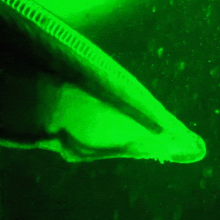Lancelet
The lancelets (/ˈlænslɪts/ or /ˈlɑːnslɪts/), also known as amphioxi (singular: amphioxus /æmfiˈɒksəs/), consist of some 30 to 35 species of "fish-like" benthic filter feeding chordates[2] in the order Amphioxiformes. They are the modern representatives of the subphylum Cephalochordata. Lancelets closely resemble 530-million-year-old Pikaia, fossils of which are known from the Burgess Shale. Zoologists are interested in them because they provide evolutionary insight into the origins of vertebrates. Lancelets contain many organs and organ systems that are closely related to those of modern fish, but in more primitive form. Therefore, they provide a number of examples of possible evolutionary exaptation. For example, the gill-slits of lancelets are used for feeding only, and not for respiration. The circulatory system carries food throughout their body, but does not have red blood cells or hemoglobin for transporting oxygen. Lancelet genomes hold clues about the early evolution of vertebrates: by comparing genes from lancelets with the same genes in vertebrates, changes in gene expression, function and number as vertebrates evolved can be discovered.[3][4] The genome of a few species in the genus Branchiostoma have been sequenced: B. floridae,[5] B. belcheri,[6] and B. lanceolatum.[7]
In Asia, lancelets are harvested commercially as food for humans and domesticated animals. In Japan, amphioxus (B. belcheri) has been listed in the registry of “Endangered Animals of Japanese Marine and Fresh Water Organisms”.[8]
Amphioxi are distributed in shallow subtidal sand flats in temperate (as far north as Norway[9]), subtropical and tropical seas around the world.[10] The only exception is Asymmetron inferum, a species known from the vicinity of whale falls at a depth of about 225 m (738 ft).[11] Although they are able to swim, adult amphioxi are mostly benthic. They live in sandy bottoms whose granulometry depends on the species and the site,[12] and they are usually found half-buried in sand.[10] When disturbed, they quickly leave their burrow, swim a short distance, and then rapidly burrow again, posterior end first, into the sand. Adults (B. floridae) can tolerate salinities as low as 6‰ and temperatures from 3 to 37 °C (37 to 99 °F).[13]
Their habitat preference reflects their feeding method: they only expose the front end to the water and filter-feed on plankton by means of a branchial ciliary current that passes water through a mucous sheet. Branchiostoma floridae is capable of trapping particles from microbial to small phytoplankton size,[14] while B. lanceolatum preferentially traps bigger particles (>4 µm).[15]
Lancelets are gonochoric animals, i.e. having two sexes, and they reproduce via external fertilization. They only reproduce during their spawning season, which varies slightly between species — usually corresponding to spring and summer months.[12] All lancelets species spawn shortly after sunset, either synchronously (e.g. Branchiostoma floridae, about once every two weeks during spawning season[13]) or asynchronously (Branchiostoma lanceolatum, gradual spawning through the season[16]).
Nicholas and Linda Holland were the first researchers to describe a method of obtaining amphioxus embryos by induction of spawning in captivity and in vitro fertilization.[17] Spawning can be artificially induced in the lab by electric or thermal shock.[18]



